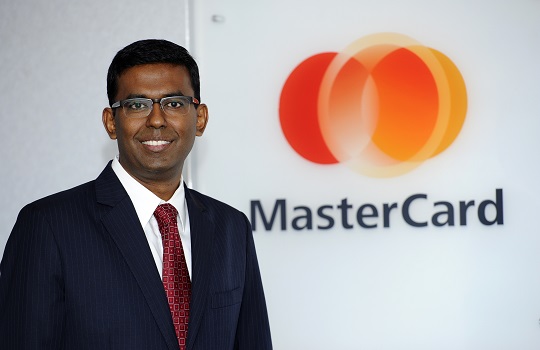
MasterCard’s Group Head of Digital Payments for Asia Pacific speaks to FST Media about what mobile payments will look like in 2020.
FST Media: What is the ‘holy grail’ that is yet to be delivered in financial services?
Dhamodharan: I don’t believe there is one ‘holy grail’ for anything. That term means different things for different consumers. Digital consumers can be segmented into two types: ‘mobile first’ and ‘PC first’. Consumers of the former use mobile devices as their primary digital device while consumers of the latter often have multiple devices but prefer to use PC as their primary device for transactions.
In both segments, our objective is to deliver simple and safe ways to complete electronic payments. We do that via our digital wallet initiative MasterPass, contactless payments, mobile Point-of-Sale devices and working through various third party wallets including Apple Pay, Samsung Pay and Android Pay.
FST Media: With the growing proliferation of contactless payments, can you tell me more about your work with UOB Mighty and what can MasterCard members expect to see next year?
Dhamodharan: UOB Mighty came out of MasterCard and UOB’s shared goal of providing convenient, secure payment experiences for our consumers. We have a number of joint initiatives to achieve that end.
As contactless payment technology begins to take root in consumers’ everyday routine, MasterCard cardholders can expect to see much more innovation and resources directed towards that space.
FST Media: What are your key priorities for the next 12 to 18 months?
Dhamodharan: We are focused on driving innovation, especially in supporting the digital lifestyle of our customers. Our latest research shows that customers have indeed shifted their focus from questioning the security of mobile and digital payments to discussing the possibilities of enhanced experiences on devices.
In addition, we want to focus on making shopping experiences as frictionless as possible, without compromising on security. Take MasterPass for example – mobile commerce is seeing strong, consistent growth across markets in Asia Pacific.
To address customers’ needs for added security and convenience, we rolled out MasterPass to over 40 million consumers in Asia Pacific, most recently in Hong Kong, India, Taiwan and Japan with more markets to come in 2016. In Singapore, you can use your MasterPass wallet to book a taxi and when you get into Taxi, the driver already knows where you are going and how you are paying for it. At the end of the ride, you simply exit the taxi. This is just the tip of the iceberg. We have number of similar partnerships rolling out throughout the region where we focus on delivering unparalleled consumer experience across transportation and entertainment verticals using our MasterPass technology.
FST Media: What will mobile payments look like in 2020?
Dhamodharan: In the ever-changing technology industry, 2020 is quite far into the future. That said, we are already witnessing a few distinct trends.
Firstly, with the mobile commerce industry estimated to be worth nearly $4 trillion by 2020 and Asia Pacific alone to have 3 billion smartphone units in circulation, it is evident that consumers are embracing the convenience of going mobile. This does not even account yet for the billions of additional connected devices expected to enter the market in the form of fitness trackers, home electronics and others.
And it’s not just the shift in consumer behaviour. We also expect the definition of mobile payments to expand to encompass all digital and personal devices. With technologies such as MasterPass, tokenisation and our innovations in biometric security including Identity Check, we will be driving this change. We have made significant strides in this direction already through partnerships with many of the device manufactures including Coin, Samsung and many fashion accessory manufacturers.
Mobile payments and wearable technology will be common place and payments as we know it will become invisible to the end consumer. In-store experiences will be completely revolutionised when consumers no longer need to queue up to checkout.
FST Media: How do you encourage a culture of innovation in your team?
Dhamodharan: Innovation has always been a part of MasterCard’s DNA, especially in the five years since our chief executive Ajay Banga took the helm. Despite being in the financial services industry, which often has a “stiff-collared” reputation, we encourage our employees to participate in internal competitions and hackathons aimed at inspiring MasterCard’s next big technology-driven idea. While we have a team of dedicated technologists at MasterCard Labs, we have to ensure that innovation isn’t only contained within their unit by encouraging collaboration across different teams in the business.
For example, most recently we organised an internal hackathon called Take Initiative, held simultaneously across our seven tech hubs around the world in New York City, St. Louis, San Carlos, Dublin, Singapore, Pune and Baroda. This gave over 400 of our employees a chance to break out of the usual humdrum of office work and come up with the company’s next innovation.
The winning innovation in Singapore was a mobile app called Mo-daan (an amalgamation of “Mobile” and the Sanskrit word for “Donations”), which enables secure and convenient donations to verified charities.
Our mantra when it comes to innovating is: fail fast, fail cheap, and learn from the failure. Organising events such as hackathons and internal competitions sparks the inner innovator in our employees and the success we’ve seen from these, especially Qkr, are just the beginning.





